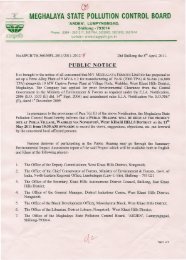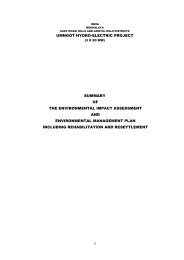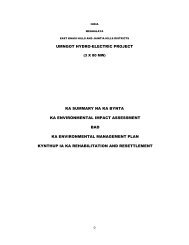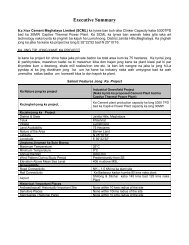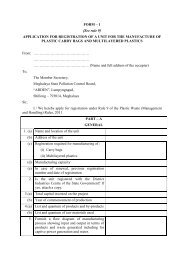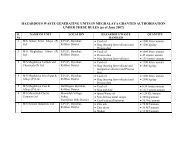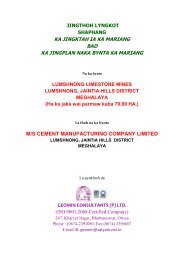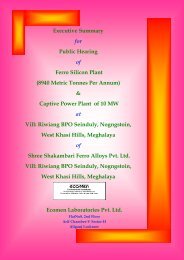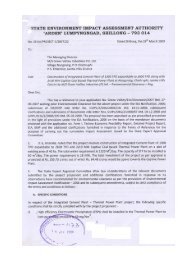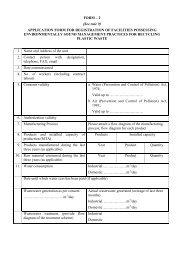chapter - 1 introduction - Meghalaya State Pollution Control Board
chapter - 1 introduction - Meghalaya State Pollution Control Board
chapter - 1 introduction - Meghalaya State Pollution Control Board
Create successful ePaper yourself
Turn your PDF publications into a flip-book with our unique Google optimized e-Paper software.
Hills Cement Co. Limited.<br />
4. Grinding<br />
After cooling, the clinker can be stored in the clinker dome, silos, and bins<br />
or outside. To produce powdered cement, the nodules of clinker are<br />
ground. Grinding of clinker, together with additions (3-5% gypsum to<br />
control the setting properties of the cement) can be done in ball mills, ball<br />
mills in combination with roller presses, roller mills, or roller presses.<br />
Power consumption for grinding depends on the surface area required for<br />
the final product and the additives used. Electricity use for raw meal and<br />
finish grinding depends strongly on the hardness of the material<br />
(limestone, clinker, pozzolana extenders) and the desired fineness of the<br />
cement as well as the amount of additives. Blast furnace slag is harder to<br />
grind and hence use more grinding power, between 50 and 70<br />
kWh/tonne. Modern ball mills may use between 32 and 37 kWh/tonne.<br />
Modern state-of-the-art concepts utilize a high-pressure roller mill and the<br />
horizontal roller mill that are claimed to use 20-50% less energy than a<br />
ball mill.<br />
Finished cement is stored in silos, tested and filled into bags, or shipped<br />
in bulk on bulk cement trucks, railcars, barges or ships. Facilities for<br />
testing the physical properties like sieve analysis, setting time,<br />
soundness, fineness, CCS, grind ability, moisture content, lime reactivity<br />
& drying shrinkage, etc. For determining the particle size distribution of<br />
the raw mix, clinker, cements, etc. a laser diffraction type PSD analyzer<br />
may be installed having typical particle size range of 0.3 mm – 400<br />
micron. To ensure consistent product quality and to permit the trouble<br />
free and cost effective operation, the quality control plan for sampling &<br />
testing of various raw materials, in-process materials and the final product<br />
is suggested.<br />
Additional power for conveyor belts and packing of cement is generally<br />
low and not more than 5% of total power use that is estimated at 1-2<br />
kWh/tonne cement. The power consumption for packing depends on the<br />
share of cement packed in bags.<br />
<strong>Pollution</strong> <strong>Control</strong> Consultants (India) Pvt. Ltd. 20


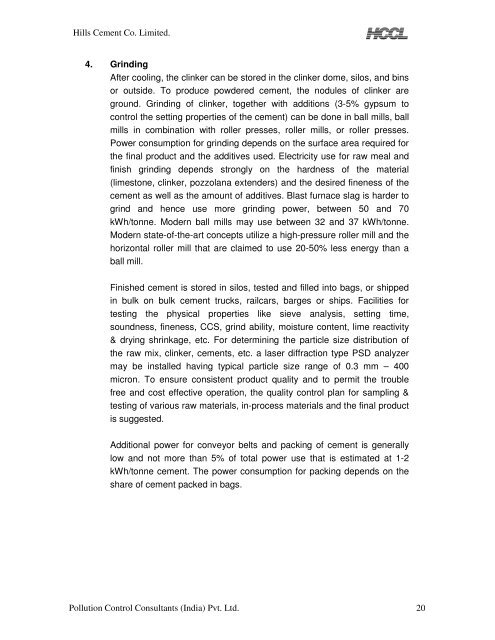
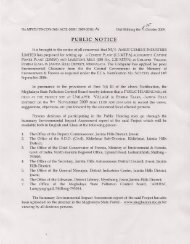
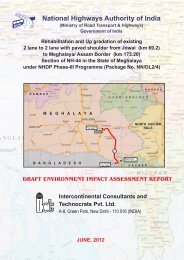

![[FORM I] - Meghalaya State Pollution Control Board](https://img.yumpu.com/49771786/1/190x245/form-i-meghalaya-state-pollution-control-board.jpg?quality=85)

